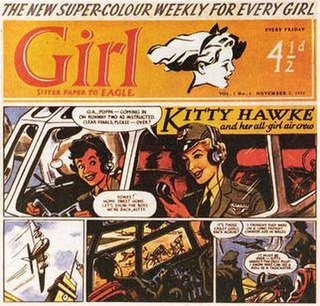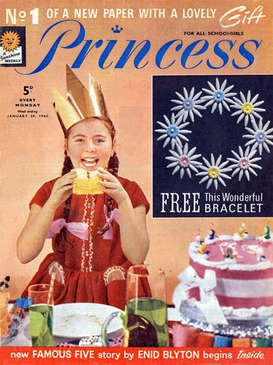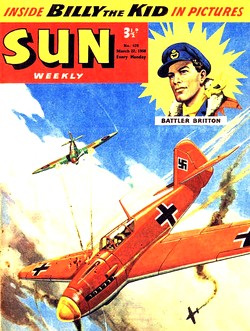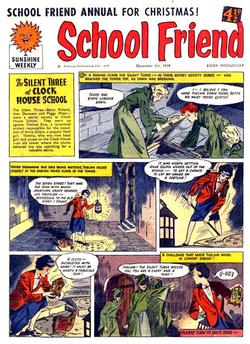
Gold Key Comics was an imprint of American company Western Publishing, created for comic books distributed to newsstands. Also known as Whitman Comics, Gold Key operated from 1962 to 1984.
The Amalgamated Press (AP) was a British newspaper and magazine publishing company founded by journalist and entrepreneur Alfred Harmsworth (1865–1922) in 1901, gathering his many publishing ventures together under one banner. At one point the largest publishing company in the world, AP employed writers such as Arthur Mee, John Alexander Hammerton, Edwy Searles Brooks, and Charles Hamilton. Its subsidiary, the Educational Book Company, published The Harmsworth Self-Educator, The Children's Encyclopædia, and Harmsworth's Universal Encyclopaedia. The company's newspapers included the Daily Mail, the Daily Mirror, The Evening News, The Observer, and The Times. At its height, AP published over 70 magazines and operated three large printing works and paper mills in South London.
A story paper is a periodical publication similar to a literary magazine, but featuring illustrations and text stories, and aimed towards children and teenagers. Also known in Britain as "boys' weeklies", story papers were phenomenally popular before the outbreak of the Second World War.

Valiant was a weekly British comics periodical published by Fleetway Publications and later IPC Magazines from 4 October 1962 to 16 October 1976. A boys' adventure comic, it debuted numerous memorable characters, including Captain Hurricane, The Steel Claw and Mytek the Mighty. Valiant lasted for 712 issues before being merged with stablemate Battle Picture Weekly.

Robot Archie is a British comic character, appearing in strips published by Amalgamated Press, Fleetway Publications and IPC Magazines. Created by Ted Cowan, the character first appeared in a serial called "The Jungle Robot" in the first issue of Lion on 23 February 1952. While the initial stint only lasted six months, Archie returned 1957 and would become one of the most enduring characters in Lion, running until the comic merged with Valiant in 1974, with the majority of his adventures drawn by Ted Kearon.

Misty was a weekly British comic magazine targeted at girls and published by Fleetway in the late 1970s. Focusing on horror stories, it was one of the few British girls' comics that was also popular with boys. Although Misty lasted less than two years it is remembered and admired to this day.

Tammy was a weekly British comic for girls published by Fleetway in London from 1971 to 1984. Tammy was closely linked editorially with the fellow Fleetway titles Misty and Jinty. At its height, Tammy sold 250,000 copies per week, more than popular IPC Magazines titles like 2000 AD.

Girl was the name of two weekly comics magazines for girls in the United Kingdom.
British girls' comics flourished in the United Kingdom from the 1950s through the 1970s, before beginning to decline in popularity in the 1980s and 1990s. Publishers known for their girls' comics included DC Thomson and Fleetway/IPC. Most titles appeared weekly, with the content primarily in picture-story format. The majority of the stories were serialized, with two or three pages per issue, over eight to twelve issues. They were marketed toward young teen girls.

Girls' Crystal was a British weekly fictional anthology publication aimed at girls. Published by Amalgamated Press and later Fleetway Publications from 26 October 1935 to 18 May 1963. Uniquely for an Amalgamated Press title, Girls' Crystal began as a story paper before transforming into a picture comic between editions, with the new format debuting on 21 March 1953. It ran for a combined total of 1432 issues before merging with School Friend in 1963.

Princess was a British weekly girls' comic anthology published by Fleetway Publications and, later, IPC Magazines. The first version was published between 30 January 1960 and 16 September 1967, and featured a mix of comic strips, text stories and a large proportion of features; it was merged with Tina to form a new title - Princess Tina - after 399 issues.

June was a British weekly girls' comic anthology published by Fleetway Publications and IPC Magazines from 18 March 1961 to 15 June 1974. Designed as a response to DC Thomson's hit Bunty, June never quite eclipsed its Scottish rival but was nevertheless a success on its own terms, reaching 631 issues before being merged into Tammy in 1974.

Sun was a weekly British comics periodical published by J. B. Allen, Amalgamated Press and Fleetway Publications between 11 November 1947 and 17 October 1959. During this time it was also known as Sun Comic, Sun Adventure Weekly, The Cowboy Sun Weekly, The Cowboy Sun, The Sun and Sun Weekly at various points, and ran for 551 issues before merging with Lion.

Hurricane was a weekly British comics periodical published by Fleetway Publications from 29 February 1964 to 8 May 1965. The title was billed as "the companion paper to Valiant" in reference to the weekly launched by Fleetway in 1962 that had rapidly become one of the company's best-selling publications. However, while Valiant would run until 1976, Hurricane was less successful and lasted just over a year before being merged with Tiger in 1965.

Jack o' Justice is a British comic character who has appeared in eponymous strips published by Fleetway Publications. The character is a highwayman adventurer, first appeared in the anthology title Radio Fun on 22 August 1956. The strip began as altered reprints of a Dick Turpin strip from the comic Sun but after being revived in the pages of Valiant became popular enough that new adventures were commissioned. The character was partnered with Moll Moonlight in his adventures - a rare example of a prominent female character in boys' comics of that time. The strip was succeeded in 1966 by Jack Justice, featuring a descendant of the characters.

School Friend was a British weekly girls' comic anthology published by Amalgamated Press and Fleetway Publications from 20 May 1950 to 23 January 1965. Considered the first British girls' comic and bearing the same name as a popular story paper previously published by Amalgamated Press, School Friend was a huge success and effectively kickstarted the genre in British publishing.













